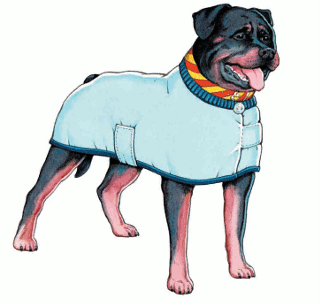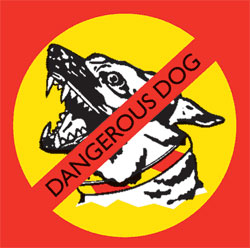Keeping requirements for declared dangerous dogs

Requirements for keeping declared dangerous dogs
Owners of dangerous dogs have imposed on them a series of obligations to make sure that members of the public are not attacked by their dog. There are penalties for noncompliance.
This page provides an overview of the requirements relating to dangerous dog provisions in the Act and the prescribed requirements in the Domestic Animals Regulations 2025. This information can also be viewed on the Dangerous dogs fact sheet ![]() [PDF File - 450.7 KB].
[PDF File - 450.7 KB].
Microchip identification
The owner of a declared dangerous dog must make sure the animal is implanted with an ISO microchip in accordance with the regulations.
Within 7 days of the dog being microchipped, the owner must supply to the council where the dog is registered:
- the microchip identification number
- other information specified in the regulations.
Desexing
It is a requirement to desex all dangerous dogs that have been declared due to an attack. Newly declared dogs (due to attack) must be immediately desexed unless the owner obtains a certificate from a vet stating the dog cannot be desexed for health reasons.
Collar

Whilst a microchip is a permanent form of identification it is not visible. Dangerous dogs must also wear a prescribed collar at all times.
The collar is specially designed to be visible from a distance and is reflective at night. This means that at all times, whether on the owner's property or not, a dangerous dog can be recognised from a distance. This warns a person of the potential danger of the dog.
Collars for dangerous dogs must:
- have at least one of the two colours able to reflect light in the dark
- be made of durable materials
- be able to be securely fastened
- consist of red stripes alternately spaced with yellow stripes each being of a width of not less than 20mm and not more than 30mm and set diagonal to the rim of the collar.
Have a minimum width of:
- 25mm for a dog weighing not more than 40 kgs
- 50mm for a dog weighing more than 40 kgs.
Signs

It is important for a person with a valid reason to enter the premises (such as emergency services personnel) to know a dangerous dog is present.
The owner of a dangerous dog must display prescribed warning signs at all entrances to the premises where the dog is kept warning people that a dangerous dog is kept on the premises.
This warning sign must:
- be square with sides of at least 40cm
- be made of durable metal
- comply with the Domestic Animals Regulations 2015
- have at least one colour that is reflective.
For details of suppliers of dangerous dog warning signs, contact your local council, or phone the Customer Service Centre on 136 186.
Housing your dangerous dog
When indoors or in an outdoor enclosure, the dog must be housed in such a way that:
- it cannot escape
- prevents the dog from injuring visitors to the premises.
The dwelling and enclosure must both be constructed in such a manner that a person cannot have access to them without the assistance of an occupier of the premises who is of or over 18 years of age.
The owner must also provide an outdoor enclosure that must:
- be fully enclosed
- contain walls, a floor, a drain, a roof and a gate which comply with the detail below
- have a weatherproof sleeping area
- have a minimum floor area of ten square metres per dangerous dog
- have a minimum height of 1.8 metres
- have a minimum width of 1.8 metres.
The walls of the enclosure must be fixed to the floor and constructed to be no more than 50mm from the floor. The walls, roof and gate of the enclosure must be constructed of:
- brick, timber, iron or similar solid materials
- chain mesh manufactured from a minimum of 3.15mm wire to form a uniform 50mm mesh
- weldmesh manufactured from 4mm wire with a maximum mesh spacing of 50mm.
A combination of these may be acceptable. The mesh size and construction detail is specified so that the enclosure will be escape proof and so that people, particularly small children, cannot fit body parts such as hands into the dog enclosure.
The floor of the enclosure must be constructed of concrete and be graded to a drain for the removal of effluent.
The gate on the enclosure must contain a lock and it is a requirement that the enclosure is kept securely locked when the dog is in the pen.
Restraint
A dangerous dog must be muzzled and on a lead whilst it is outside the owner's dwelling and the dog's enclosure.
Dangerous dogs found at large
If a dog that has previously been declared as a dangerous dog (due to attack) is found wandering at large, it can be seized and impounded and euthanised after 24 hours.
Owners must contact the council within 24 hours of impoundment if they wish to prove there were mitigating circumstances for the dog being at large (if this can be proven, the owner may be able to reclaim the dog).
Notification
The owner of a dangerous dog must notify the council within 24 hours if:
- the dog is missing
- the ownership of the dog changes
- the owner's address changes or the place where the dog is kept changes and must provide new address.
If there is a change in the municipality where a dangerous, menacing or restricted breed dog is kept, owners must inform both the council of the municipal district in which the dog was previously kept and the council of the municipal district in which the dog is being kept within 24 hours of the change.
This keeps the council informed of the location of dangerous dogs at all times. The council will inspect the premises to make sure the regulations are being adhered to.
Owners who sell, give away or transfer the ownership of a dangerous dog must notify the new owner in writing that the dog is deemed dangerous.
Please email pet.welfare@agriculture.vic.gov.au if you would like a sample notification letter.
Attacks by dangerous dogs
Owners of dangerous dogs are subject to criminal offences if their dog kills or endangers the life of someone.
Owners can be jailed:
- for up to 10 years if their dog kills someone
- for up to 5 years if their dog endangers someone's life.
This applies to owners of:
- attack trained dogs
- dangerous dogs declared due to attack
- declared menacing dogs
- guard dogs
- restricted breed dogs (both registered and unregistered).
Other matters
Councils have the power to charge higher registration fees for dangerous dogs that have been declared due to attack, than the standard maximum pet registration fees.
The Domestic Animals Regulations 2025 provide for and ensure a state-wide standard relating to the management of dangerous dogs. The uniform identification of dangerous dogs, and the identification of premises where they live is important for easy identification of these dogs.
It is also vital for effective state-wide education programs, directed particularly at children.
Where the owner of a dog is under the age of 18 years, the parent or guardian of that owner will be deemed the legal owner of the dog and subject to any penalties or prosecutions.
Download this page in PDF format: